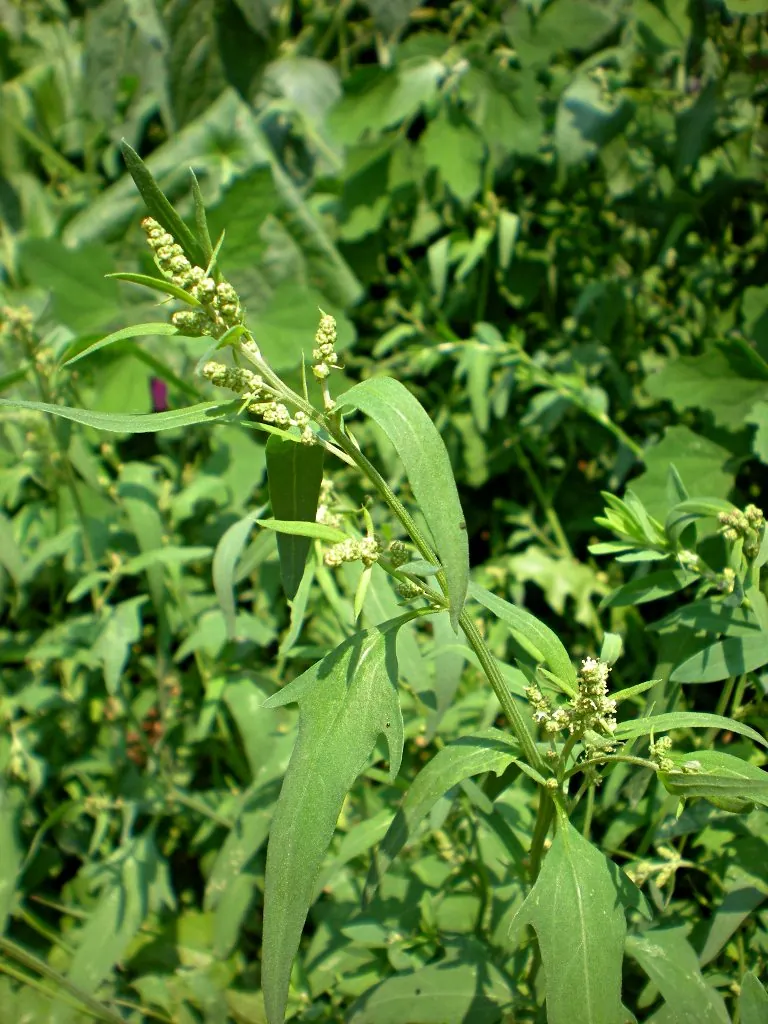
A common and insignificant weed, but a member of an
illustrious tribe of edible leafy vegetables, and a
close relative of the garden Orach (A. hortensis).
The species is variable, and so is the taxonomy; in
Shafer’s Preliminary List of the Vascular Flora of
Allegheny County, Pennsylvania, both Atriplex
hastata and A. patula are recorded;
but Gray makes A. hastata a variety of A.
patula, and places it chiefly in salt marshes.
The family Chenopodiaceae is included by many modern
botanists as a subfamily of Amaranthaceae; but the
current Flora of North America at efloras.org retains
it as a separate family.
Flowers. Insignificant; in greenish branching
spikes, terminal and in upper leaf axils, interrupted
by small leaves.
Leaves. Narrowly hastate; that is,
arrowhead-shaped, with lower lobes pointed outward or
forward; mid-green above, more greyish below; on short
slightly winged petioles; texture somewhat rubbery.
Stem. Thin, angular; producing small branches
in leaf axils; smooth; bright green.
Gray describes the genus and the species:
ÁTRIPLEX [Tourn.] L. ORACH. Flowers monoecious or
dioecious; the staminate like the flowers of
Chenopoidium, but sterile by the abortion of the
pistil; the fertile consisting simply of a naked
pistil inclosed between a pair of appressed foliaceous
bracts, which are enlarged in fruit, and sometimes
united. Seed vertical. Embryo coiled into a ring
around the albumen. In one section, including the
Garden Orach, there are some fertile flowers with a
calyx, like the staminate, but without stamens, and
with horizontal seeds. — Herbs (ours annuals), usually
mealy or scurfy with bran-like scales and with
spiked-clustered flowers; in summer and autumn. (The
ancient Latin name, a corruption of the Greek, atraphaxis.)
A. pátula L. Erect or prostrate (3-12 dm.
high), glabrous or somewhat scurfy; leaves narrowly
lanceolate-hastate (2-10 cm. long), the lower
sometimes opposite, entire or sparingly
sinuate-dentate, petioled, the upper lanceolate to
linear; flowers clustered in rather slender spikes,
the two kinds together or separate; fruiting bracts
ovate-triangular or rhombic-hastate, entire or
toothed,often muricate on the back, united to near the
middle. —Nfd. to N.J., Mo., and B.C. (Eu.) Very
variable; the marked extremes are: Var. hastàta (L)
Gray. Erect or spreading, stout, at least the lower
leaves broadly triangular-hastate, often coarsely and
irregularly toothed. — Nfd. to Va., Mo., and
northwestw., chiefly in saline places and along the
Great Lakes. (Eu.) Var. littoralis (L.)
Gray. Slender; leaves linear-lanceolate to linear,
rarely subhastate or toothed. — P. E. I. to N. J., and
westw. along the Great Lakes.